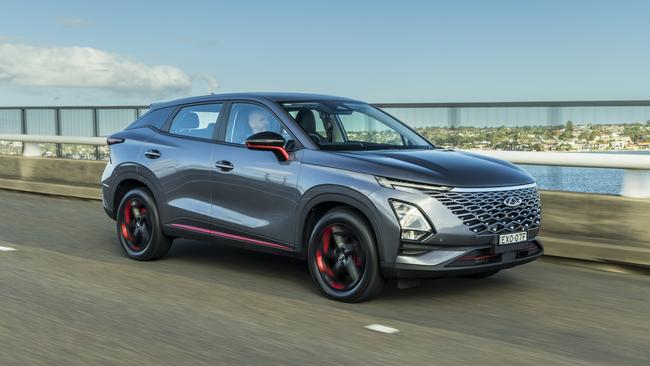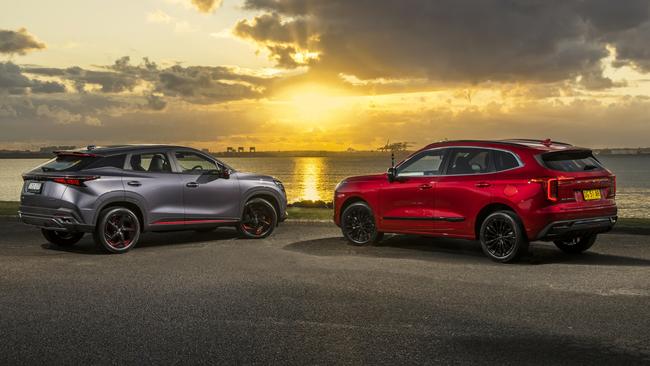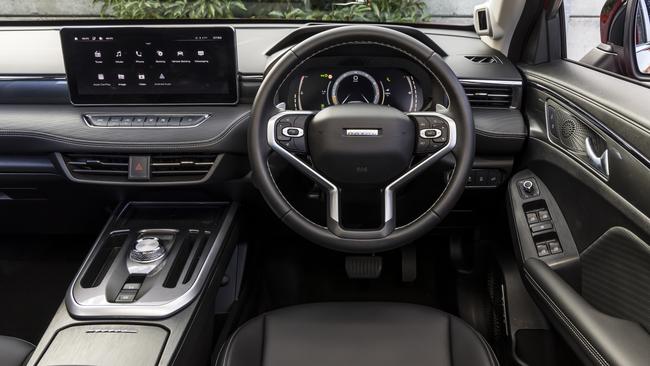Chinese cars compared: Chery Omoda 5 and Haval Jolion
Established manufacturers have turned their back on affordable cars – but a new breed of machine has stepped up to the crease.
Motoring News
Don't miss out on the headlines from Motoring News. Followed categories will be added to My News.
Mainstream makers have ditched their cheapest cars and raised the price of others in recent years, leaving a void at the bottom end of the car market.
Chinese car brands have exploited the opportunity with cars combining affordable price tags with long lists of standard equipment that shine in the showroom.
We put the popular Haval Jolion up against the new Chery Omoda 5 to find out if all that glitters is really gold.

CHERY OMODA 5
The Chery is the new kid on the block, returning to Australia after a 10 year hiatus. Gone is the $9990 drive-away J1 hatchback of the first iteration, replaced by the Omoda 5 compact SUV.
Prices start at about $32,000 drive-away for the base version and about $35,500 for the better equipped EX tested here. That puts it up against sparsely equipped mainstream players such as the Kia Seltos, Toyota Corolla Cross or a near top-spec versions of the ageing Mitsubishi ASX.

Chery’s styling is bold but might not be for everyone with a gaudy grille, black and red 18-inch alloy wheels, a coupe-like roofline, LED lighting and dollops of red highlights all over.
On paper the Chery jumps off the page. Buyers can expect a laundry list of standard equipment that wouldn’t look out of place on a $100,000 luxury car.
Inside there are dual 10.25-inch displays; one for the infotainment and the other for the driver’s instruments, though the latter is a tad fussy and harder to read than the Haval’s streamlined graphics. Apple CarPlay, Android Auto and Bluetooth are standard. The Chery’s eight-speaker Sony stereo trumps the Jolion’s unbranded six-speaker unit.
The dash has easy to use digital buttons for the climate control and there are high quality materials used throughout but hard wearing plastics dominate below your eye line.
Faux leather wrapped seats with contrasting stitching look like they have been pulled from a Mercedes-Benz. Both front seats are electronically adjustable and heated.

A heated chunky flat-bottomed steering wheel has both reach and height adjustments. Jolion drivers can only move it up and down.
Chery’s AI assistant works well. It responds to “Hi Chery” prompts and allows you to ask it to open or close windows or the sunroof among other commands.
On the road the lustre comes off the Chery’s shiny showroom appeal.
Its 1.5-litre turbo petrol engine is willing and works well with the CVT auto that makes the most of the 115kW and 230Nm on tap.
Around town and on the motorway it works admirably, finding the correct ratio to deliver the right amount of oomph.
The combination of ultra light steering with minimal feedback and super soft suspension doesn’t provide confidence on twisting back roads.

The suspension is too soft, struggling to recover from big bumps. It also manages to feel crashy over smaller consistent road imperfections. It would benefit from better tyres, as the Giti rubber protests consistently through corners.
The Chery is quieter in traffic and the open road. Chery claims it drinks 6.9L/100km that is better than the Jolion’s 7.5L/100km. Both are below average for turbo engines, but they only require the cheapest unleaded fuel.
HAVAL JOLION
The Haval Jolion range starts at just $28,490 drive-away and comes with either turbo petrol or hybrid power.
We are testing the Jolion S, the most expensive petrol model priced at $36,990 drive-away, but until the end of financial year buyers can get a $1000 discount. Both SUVs are guaranteed for seven years and unlimited kilometres, providing peace of mind to customers.

Each is covered by a capped price servicing program; the Jolion will cost you $1550 over five years, which is $150 more than the Omoda 5.
The Jolion is more conventionally styled with a boxy silhouette, a comparatively understated chrome grille and black 18-inch alloy wheels.
It has a big 12.3-inch central display, digital driver screen and wireless device charger but doesn’t feel as hi-tech and luxe as the Omoda 5.
The sunroof is bigger and it has a head-up display that projects vital information such as your speed and safety warnings onto the windscreen in front of the driver. It misses out on desirable features such as a power tailgate, ambient lighting and puddle lights that project on the ground from the side mirrors that are standard on the Omoda 5.
The Jolion’s cabin feels airier with bigger windows and more head and shoulder room. Rear vision is better too.

Each has a full array of safety equipment but the Jolion’s tech works better. The lane keep assist feature gently steers you back into place where the Omoda 5 ping pongs around the lane and its radar cruise control button didn’t work.
The Jolion’s engine makes 130kW/270Nm. The strong motor is let down by a hesitant seven-speed dual clutch transmission that is laggy on take off and far too assertive once it makes up its mind.
Sturdier Khumo tyres provide superior grip in the wet. Firm suspension is jittery and loud over bumps of all shapes and sizes.
Heavier and more direct steering makes for a more reassuring drive experience in the Haval.
VERDICT
The Jolion’s more practical cabin and relatively better drive experience edge ahead of the Omoda 5’s value-packed cabin.
Haval Jolion S
PRICE: $36,990 drive-away
ENGINE: 1.5-litre turbocharged four-cylinder petrol, 130kW and 270Nm
WARRANTY/SERVICING: seven year/unlimited km, $1550 over five years
SAFETY: 7 airbags, auto emergency braking, lane keep assist, blind spot detection, rear cross traffic alert, exit warning, radar cruise control, 360 degree camera
THIRST: 7.5L/100km
SPARE: Space saver
LUGGAGE: 430-litres

Chery Omoda 5 EX
Price: About $35,490 drive-away
Engine: 1.5-litre turbocharged four-cylinder petrol, 115kW and 230Nm
Warranty/servicing: seven year/unlimited km, $1400 over five years
Safety: 7 airbags, auto emergency braking, lane keep assist, blind spot detection, rear cross traffic alert, radar cruise control, 360 degree camera
Thirst: 6.9L/100km
Spare: Space saver
Luggage: 360-litres



